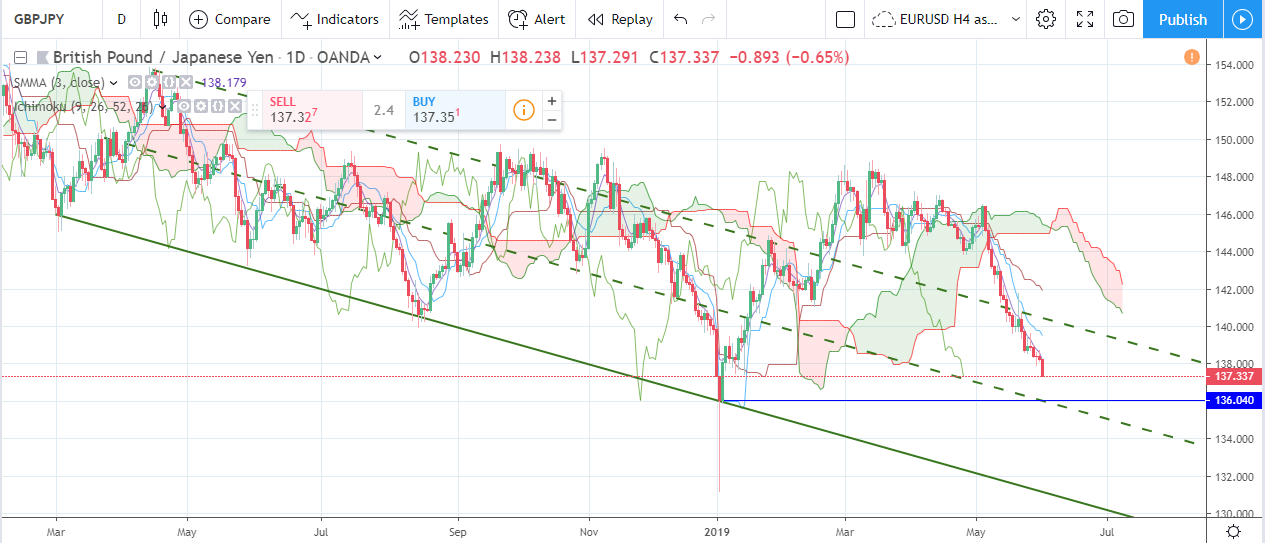How deep can GBP/JPY dive in June?
Brexit is one of the most stupid decisions ever made by Britons, according to several politicians. The country is stuck in the middle of nowhere in terms of the internal political situation, relations of Parliament and Premier Minister and negotiations with one of the most considerable international partners - the European Union. Such a cocktail of poisoned factors forced Theresa May to resign, admitting her inability to solve the issue and get the United Kingdom out of the corner. May’s resignation was comprehended as a totally uncertain factor for the Sterling, and currency speculators sold the currency off across the board. GBP is constantly one of the weakest currencies several weeks in a row.
What’s worse, the Bank of England does not have any influence on the pound’s crash. The regulator cannot whether to cut or hike the interest rates until political uncertainty was resolved. The British economy is doing pretty well, the latest macroeconomic data showed strength in earnings, consumption and spending as the retail sales grew in the country in March and April. The labour market is robust, exports are growing, the GDP report points to the economic recovery after the Brexit chaos. However, soft inflationary pressure does not allow the regulator to tighten financial conditions in the United Kingdom as the latest Consumer and Producer Price indexes failed to meet the market’s expectations. BoE Monetary Policy Committee officials are trying to support the Sterling verbally, stating that things are better than they could be. But that does not really help as currency speculators, and real-money traders keep selling the pound.
On the side of the equation, the situation in Japan is also bad. Despite the pick up in the industrial and manufacturing activity, the latest trade balance report showed much worse-than-expected volume of exports. The third largest world’s economy is traditionally dependant on exports, and drop in the revenue for three months in a row would hurt the investment activity in the country significantly. The Japanese yen has a traditional inverse correlation with the economic data as USD/JPY works as a risk-appetite indicator. The main reason for that is related to negative interest rates in Japan as the central bank is always trying to support local exporters by capital outflow. Japanese corporations invest abroad a significant part of their profits and revenues. Therefore, soft monetary policy and cheap borrowing capital weaken the currency, allowing exporters to benefit additional competitor advantage. During turmoil periods when global equities are getting sold off, and safe-haven assets are in demand, the yen strengthens.
Japan was also one of the first major countries to react to U.S. China trade wars. Recent development showed that the Chinese side is not intended to get back any of their positions in trade deal conditions. Moreover, China is ready to retaliate, announcing mirror measures to Trump’s import tariffs. Xi and Trump are going to meet each other in G20 summit in Japan in June, but recent headlines do not promise too high chances for a deal in the nearest term. Therefore, global investors would not have too large risk appetite in such circumstances when the global economy is under a threat of a recession if not turmoil. Summer vacation season is traditionally inactive, and buyers could come back to the market as early as in September. Falling stock indices and growing demand for Bonds would support the Japanese yen, adding selling pressure on the GBP/JPY cross rate.
When it comes to the technical analysis, GBP/JPY went back down to the descending channel which worked since the peak in February 2018. The daily chart below shows a totally negative sentiment for the cross rate with lots of targets to achieve in this upcoming month. The nearest one is placed at the middle of the descending channel in the range of 135.50/136.00. Recent bearish momentum points to the fact that the distance of 150-200 pips is nothing the pound-yen and it could be reached in a couple of days. The whipsaw, which was charted on January 3, was nothing but a water test as hedge funds were trying to find levels where large orders are placed. The daily close at 136.04 confirms the above calculations of support levels. If the horizontal static support line was breached, we could see GBP/JPY edging lower to the bottom line of the bearish channel, and the exchange rate could drop as low as 130 yen per pound. The Ichimoku Cloud trend indicator is extremely bearish, pointing to the downtrend continuation. Signs of a possible reversal are completely absent. Therefore, the only question is in the speed of pound-yen’s freefall.

Read also